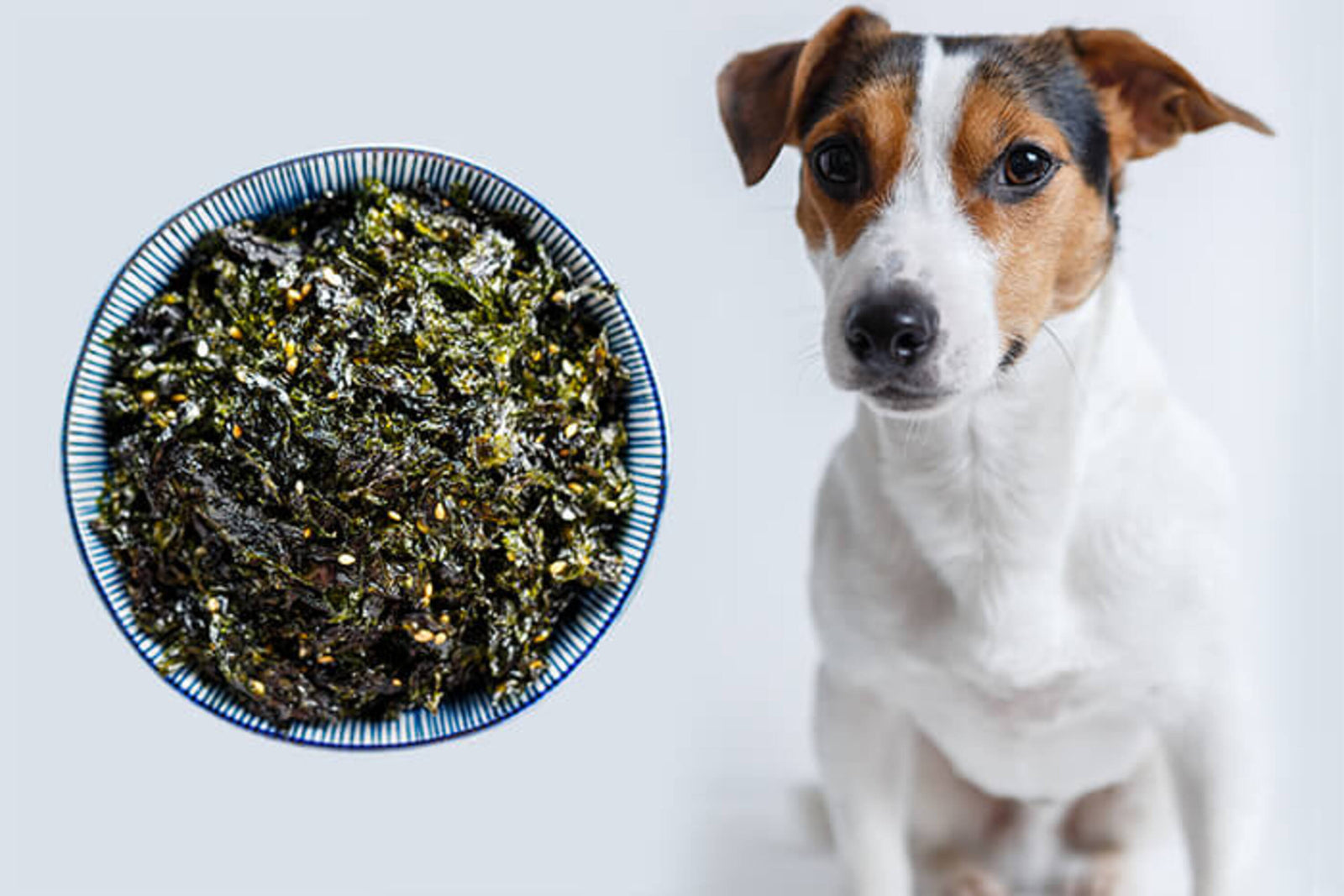First introduced with sushi, seaweed has become a popular snack in America. In fact, it’s often recognized as a superfood due to its nutritional value and many health benefits. But can you share seaweed with your dog?
Well yes, dogs can eat seaweed. The nutrients that make this sea vegetable healthy for us, are also incredibly beneficial to your pup’s health. But that being said, there are certain things to keep in mind to avoid any harmful side effects.
In this article, we’ll discuss everything you should know before feeding seaweed to your dog.
4 Awesome Health Benefits of Seaweed for a Dog
Let’s first start by discussing the 5 amazing health benefits of feeding seaweed to your dog.
1. Improves Thyroid Function
Seaweed is a rich source of iodine. It’s a trace mineral and an essential component of triiodothyronine (T3) and thyroxine (T4). These are two thyroid hormones that are required for the proper growth and development of your dog’s organs, especially the brain. They are also responsible for regulating metabolic activities in cells.
Adding seaweed to your dog’s diet can help prevent iodine deficiency, which is a common health condition that often leads to thyroid disorders.

2. Provides Omega-3 Fatty Acids
Omega-3 fatty acids are polyunsaturated fatty acids that are categorized into 3 sets α-linolenic acid (ALA), eicosapentaenoic acid (EPA), and docosahexaenoic acid (DHA).
Seaweed contains both DHA and EPA that support various functions in your dog’s body, such as:
- Helps improve the condition of skin and coat
- Prevents dry flaky skin and skin allergies
- Supports the immune system
- Relieves joint pain and stiffness
- Provides anti-inflammatory benefits
It’s also important to note that a dog’s body doesn’t produce omega-3 fatty acids. If you want your dog to enjoy the benefits of these acids, you should incorporate supplements like seaweed into their diet.
3. Supports Digestive Health
Seaweed contains both soluble and insoluble fibers that help support the digestive health of your dog. While the soluble fiber removes excess fluid from the body and prevents diarrhea, insoluble fiber adds bulk to the stool and provides a laxative effect that prevents constipation.
Fiber gets fermented into fatty acids which is beneficial for the good bacteria found in your dog’s intestine. This acid also prevents the overgrowth of bad bacteria and helps the dog’s colon recover from injuries faster.

4. Provides Vitamins & Minerals
Seaweed is packed with vitamins and minerals. It contains vitamin A which supports healthy vision, vitamin B1 which promotes motor and cognitive function, and vitamin B2 which is responsible for the metabolism of fats and carbohydrates into energy.
It also contains vitamins C and E which are two powerful antioxidants that protect the dog’s body against harmful free radicals and help prevent inflammation and cognitive aging in older dogs.
In the minerals section, seaweed contains high amounts of calcium which supports the growth of healthy bones and teeth. It’s also an essential mineral required for proper muscle function, blood coagulation, and a healthy nervous system.
Furthermore, seaweed also offers potassium which is an electrolyte that regulates fluid balance in the body and aids the transmission of impulses from the brain to the body. It also contains magnesium which is required for energy production at the cellular level. These minerals work together to support various enzyme functions in your dog’s body.
5. Low-Calorie Content
Seaweed contains only a few calories which makes it a perfect snack for dogs that are trying to manage their weight. You can add it as a supplement to their diet to provide them with many essential nutrients without adding too many calories.
How to Feed Seaweed to Your Dog
The seaweed dishes you make for yourself aren’t always safe or healthy for a dog. Even the packed seaweed snack that you have bought for yourself may not be safe for your dog as it might contain additional ingredients or seasonings that can be harmful to dogs.
To safely feed seaweed to your dog, buy packed unseasoned dog-friendly seaweed that doesn’t contain any additional ingredients. You might find it in dried or powder form that you can sprinkle on your dog’s daily meals.
There are also plenty of dog-friendly snacks like seaweed sheets available in the market. You can serve these in between meals or as a training treat to your dog.
But avoid food items like sushi and salad that contain seaweed as these also contain other harmful ingredients like onion, garlic, etc.
Also, remember to serve seaweed in moderation and as a supplement to a healthy well-balanced meal. Overeating seaweed can lead to an upset stomach, nutritional imbalance, and other health issues.
While the ideal amount will vary depending on your dog’s health and nutritional requirements, seaweed shouldn’t make up more than 5-10% of your dog’s weekly diet. If you are buying powdered seaweed supplements, you can follow the directions mentioned on the pack by the manufacturer.
It's best to discuss with your veterinarian any supplements you wish to consistently feed to your dog.
What Type of Seaweed is Safe for Your Dog
There are thousands of species of seaweed. Some of which are available in the market for both humans and dogs. To avoid any confusion, let’s also discuss the 4 most common and nutrient-rich types of seaweed you can buy and feed to your dog:
1. Kelp
Kelp is a large brown seaweed that grows in the “underwater forests" in shallow oceans. It’s harvested for various purposes and is a commonly used ingredient in both human and dog food.
Kombu and wakame are two popular forms of edible kelp available in the local market.

2. Dulse
Dulse is a reddish seaweed that grows on the northern coasts of the Atlantic and Pacific Oceans. It’s most commonly used as food or medicine. You can find dried, shredded, and powdered dulse in your local market.

3. Nori
Nori is a popular seaweed used in Japanese cuisine. It’s roasted and pressed into sheets that are used to wrap rolls of sushi or rice balls. You can buy packs of unseasoned nori sheets from the supermarket to serve as a treat to your dog.

4. Sea Grapes
Sea grapes also known as green caviar are species of seaweed from the coastal regions in the Asia-Pacific. These look like tiny balls and are often considered a delicacy seaweed with a texture similar to caviar. You can buy dried or powdered sea grapes for your dog.

Precautions While Feeding Seaweed to a Dog
If you aren’t careful, seaweed can have many dangerous side effects for your dog. To avoid such situations, take note of the following precautions.
Stay Away From The Wild Seaweed
Your dog should never eat wild seaweed that has washed up on the beach. It can be fatal for their health.
First, there’re chances that the seaweed has been lying on the beach for some time. It might have accumulated pollutants and dangerous metals that can adversely affect your dog’s nervous system, kidneys, and immune system. There’s also a risk of salt poisoning.
Second, heat and sun exposure at the beach dries and shrinks the seaweed. When consumed in large quantities, it expands by absorbing the fluid from the dog’s stomach. It can lead to severe intestinal blockage that can be very dangerous.
To avoid any such situation, keep your dog away from wild seaweed during your beach visits. And if in case they have accidentally consumed some wild seaweed, contact a veterinarian as soon as possible.

Monitor For Allergies
Even though it’s rare, your dog can still have an allergic reaction to the safe types of seaweed. It’s best to introduce seaweed in small amounts and monitor your dog’s reaction for at least 24-48 hours.
Look for any of the following signs of an allergic reaction:
- Upset stomach, vomiting, or diarrhea
- Constant itching and licking
- Red or irritated eyes
- Runny nose or continuous sneezing
- Swelling on the face, ears, lips, or eyelids
- Red or inflamed skin
- Itchy ears
If you notice any of these signs of an allergic reaction, contact a veterinarian immediately.
Feed in Moderation
Seaweed is a supplement that’s added to a dog’s diet to maintain an adequate intake of nutrients. Overindulgence can lead to many health problems including digestive disorders and nutritional imbalances.
Hence the seaweed added to your dog’s diet shouldn’t make up more than 5-10% of their weekly diet. You can also talk to your veterinarian to determine the exact amount of seaweed you should feed to your dog.
Summing Up
Seaweed is a perfect supplement to boost your dog’s daily diet. It contains omega-3 fatty acids, iodine, dietary fibers, antioxidants, and many other essential vitamins and minerals that have a ton of health benefits.
To get started just sprinkle some dried or powdered seaweed into your dog’s daily meals or buy unseasoned nori sheets and snacks to feed them as a treat. Just stay away from dried wild seaweed at the beach.
If you’re still in doubt, consult your veterinarian before adding seaweed to your dog’s diet.
FAQs
Let’s answer some frequently asked questions about feeding seaweed to your dog:
1. Can a dog eat dried seaweed sheets?
Yes, your dog can eat dried seaweed sheets. Although some seaweed sheets made for human consumption contain additional flavors or seasoning which can be harmful to a dog. It’s best to buy unseasoned seaweed sheets for your dog.
2. Can a dog eat roasted seaweed?
Yes, you can roast seaweed before feeding it to your dog. But make sure you don’t add any other harmful ingredients like onion or garlic while roasting. Keep the recipe plain to ensure everything is healthy and safe for your dog.
3. Can a dog eat seaweed snacks?
Yes, you can feed dog-friendly unseasoned seaweed snacks to your dog. But avoid feeding them seaweed snacks that are made for human consumption as they might contain additional ingredients like onion, garlic, lime, or chili, all of which can be harmful to a dog.
4. Can a dog eat seaweed salad?
Seaweed salad made for human consumption contains many other ingredients including vinegar, onion, soy sauce, oil, salt, and pepper. These ingredients can be harmful to a dog’s health. Thus it’s best to avoid feeding seaweed salad to your dog.
5. Can a dog eat seaweed if they are suffering from diarrhea?
Yes, you can feed small amounts of unseasoned seaweed to your dog when they have diarrhea. The dietary fibers present in the seaweed can help add bulk to the stool and provide relief from diarrhea.
6. Can a dog eat seaweed from the beach?
No, a dog should never eat seaweed from the beach. First, it can contain pollutants and dangerous metals that could affect your dog’s nervous system, kidneys, and immune system. Second, it’s dried seaweed that can expand in the dog’s digestive system when eaten in large amounts and cause a severe blockage.
If you’re concerned about feeding seaweed to your dog, consult with a veterinarian beforehand.
Join Our Pack
Sign up for our monthly newsletter focused on dog digestion health, cute pup stories, and the latest scoop from Nextrition.
Source:
https://www.dogsnaturallymagazine.com/sea-vegetables-and-their-health-benefits-for-dogs/
https://www.rover.com/blog/can-my-dog-eat-seaweed/





